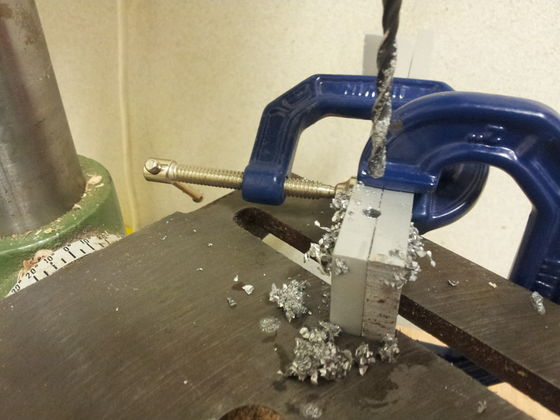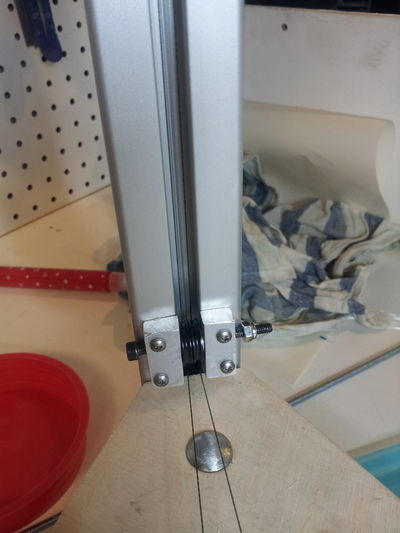Difference between revisions of "Cerberups"
m (→Heating up, extruding) |
m (→Heating up, extruding) |
||
| Line 163: | Line 163: | ||
Now I '''''really''''' want my extruder...<br><br> | Now I '''''really''''' want my extruder...<br><br> | ||
| + | |||
| + | =Movement issues= | ||
| + | |||
| + | Aside all this seemingly very good news, there is also bad news. In my enthusiasm I did press for some high speeds and the machine '''REALLY''' doesn't cope well with that. It resonates, it routinely shows very weird glitches as if the driving filament is rubber instead of spectra (jumping and hesitating and having severe hiccups and bumps, but still apparently not skipping because the attained end point is still where it is supposed to be (weird). I am unsure if my speed expectations are quite simply too high, or that I need to tweak speed settings so as to try and avoid resonance frequencies, or that the filament is too tight or too loose, the stepper current is too high or too low, some problems with bearings, whatever. Although we did experiment with the tension which didn't show improvement. | ||
| + | Maybe it is more of a software thing and acceleration settings must be tweaked and more intelligent movement commands instead of my crude GCode that tells it to very abruptly stop, change directions, etc. Who knows. But at the moment, it is no speed monster yet...<br><br> | ||
Revision as of 02:33, 5 June 2013
| Projects | |
|---|---|
| Participants | Ultratux |
| Skills | Metal- and woodworking, precision tooling, assembling, electronics, fine mechanics, creative thinking |
| Status | Active |
| Niche | Mechanics |
| Purpose | World domination |
Contents
Introduction
Cerberups, a Delta-type 3D printer. It is a slight radical modification to a US design, the Cerberus by Steve Graber of Grabercars (see https://github.com/grabercars/Cerberus). My modifications were mainly necessary to adapt from imperial to metric extrusions, but also because other choices were made in type of materials (ie. wood instead of PLA). The Cerberus itself is based on the Rostock, of course: the first delta 3D printer.
My chosen name Cerberups is a wordplay because it so differs from the original and I don't want to put people on the wrong foot by implying that mine is anything like the original (except concept and key parts). Rups is Dutch for caterpillar.
First steps
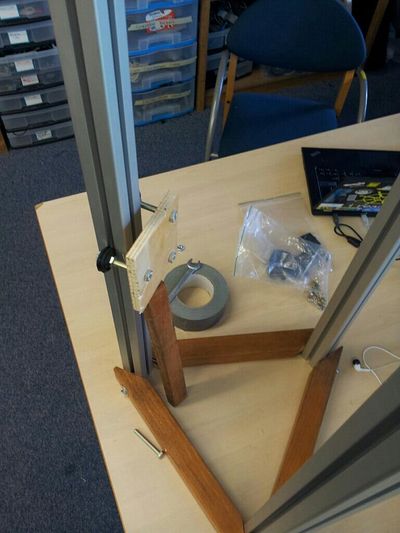
First uneasy steps. Making this triangle was rather awkward; I used some hardwood I had laying around. It was much harder than anticipated. And it's only when you need a 30 degree angle, you find that none of our tools have any setting for it, or they are so coarse/imprecise as to be completely useless... Examples: I went out to buy a mitre box with a 30 & 60 degree cut-- unobtainable. And our mitre saw has a 60 degree angle, but can't manage 30 degrees... Oh well. Lots of improvisation. Lots of extensive postwork on the very resistant wood... and in hindsight, all in vain because I quickly decided to do it differently anyway.
I couldn't resist immediately trying out the special coated 608 rollers so I improvised a wooden carriage for now.
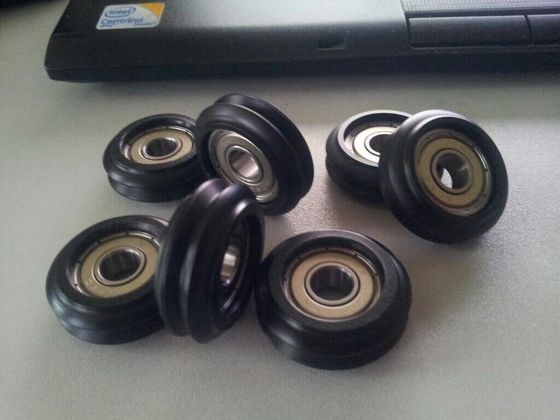
608 bearings with coat/sleeve (Delrin I believe) specially manufactured by Steve Graber on a state-of-the-art CNC lathe. These are at the heart of the vertical movement system used in the Cerberus. Get these babies wrong, and gone is precision & accuracy, and gone is silent movement. I ordered the rollers, idler wheels and filament drive reels at Steve Grabers webshop. Couldn't have done this entire project without those.
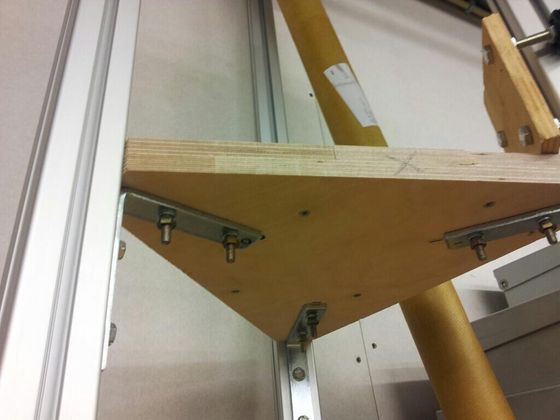
Decided to go with wood instead of printing in PLA, for a host of reasons; Our other printer is in a state of constant testing, rebuilding, breaking and fixing and not deemed production ready yet. Secondly these printed parts are so massive I'd need to babysit our printer for 48 hours or more, even if it doesn't fail halfway. And third, adaptation from imperial to metric proves hard to do, since my extrusions also have a slightly different profile, so it needs a lot more work than just scaling up by 105%, sadly.
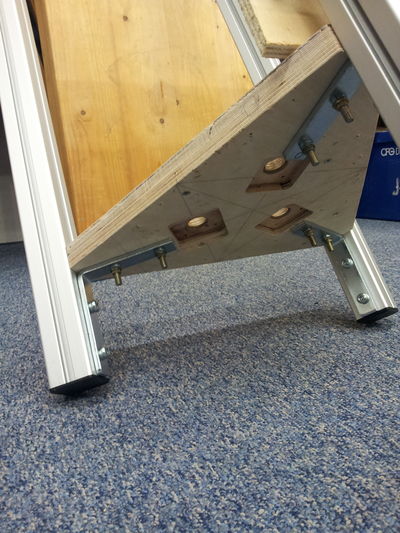
Routed holes for stepper motors
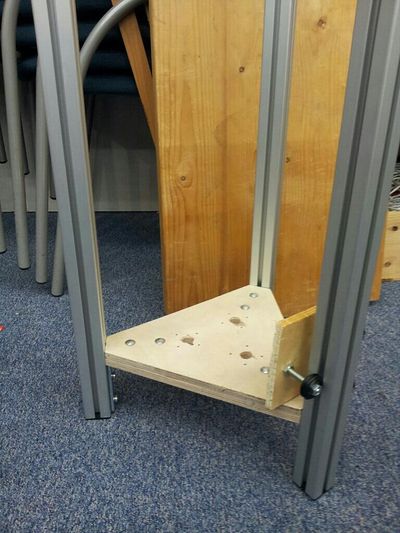
After retrieving my router and making the mounts for the three steppers, I could now bolt it in place in a more permanent fashion. Not too happy with the extrusions not being 100,0% parallel yet, but we're getting there. Robustness though, is already quite good now.
I must await delivery of the stepper motors and must find a way to get the three carriages printed. In the meantime I will find some means to re-make the bottom dual idler mounts and the top idler + tensioner in something other than PLA. So, get creative, Maarten!
Milestone one
My stepper motors have arrived. I mounted them, I filed a notch into the axle to help the set screw grip the axle. All that wasn't very interesting nor hard, so I've included no pics of that.
Then I did work on the bottom idlers block, made from thick aluminum and drilled in interesting and difficult ways with the drill press. Bit of trivia: A thick enough piece of aluminum was hard to find, or even near-impossible to find. I wandered around in my local shop until I got lucky in the coat hangers / shelf support aisle: I found a support made of good, thick 8mm aluminum. I even used other parts a bit later on, quite unexpected and quite welcome.
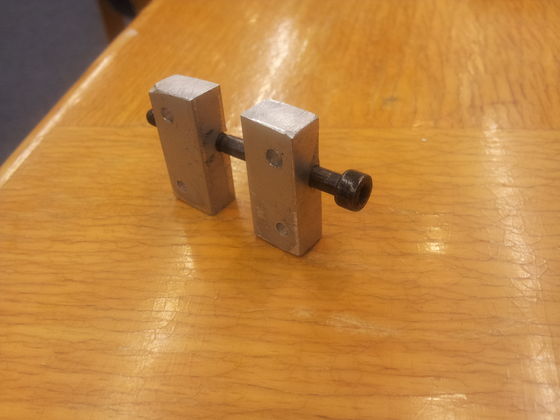
Finished bottom idler support block. I had to specially buy a 4.1 mm drill to make the ID of the idlers a tad larger, because a 4.0mm ID idler does not fit on a 4.0 mm OD rod. Well, it fits, but then you'd need pliers to turn it...
But I really hit a brick wall trying to design the top idler/tensioner. First I attempted something that slid into the gap in the extrusion completely, but I got stuck trying to join two thin aluminum plates to a center piece, without any part or bolt protruding. As it turned out, gluing proved infeasible too; epoxy reportedly can glue metals fine, with the exception of... aluminum. :-(
Then I thought something up: I could use one of the corner round holes to put a threaded rod there, and use a nut to raise it to provide the tensioning mechanism. Then from there the idea developed further and further. Two trips later and I had made it from M5 threaded rod, a partly sawed hinge and some other parts. \o/
It did need some hard, precise and error-prone machining though. It may be interesting to read: As I have very little room in the extrusion, I deployed coach bolts, whose heads I made really thin and flat with a grinder. That was nice but it has obvious drawbacks too of course; I needed to file round the square inset of the shaft too, 'cause that is where my idler would be. And then, finding a ring with ID that fits over that rounded shaft and OD to fit inside the 8mm ID idler... that was a bitch. I could not deploy plastic bushes like you find in electronics, since the plastic against plastic really didn't feel it would run smoothly. I sadly had no immediate source of small pipes/tubes at the time I wanted to test/finish my design. After again a walk through my department store I came to the realization that the aluminum support I had bought as my source of thick aluminum was also equipped with an aluminum rod which measured... 7,7 mm OD. Wow... talk about being lucky! A bit of work with drill, saw, file and caliper and it was done.
Next up was of course threading the whole assembly to make a working proof-of-concept with a single column. Threading the drive-filament proved extremely hard; it is astonishingly hard to try to attach the thin wire in the inside of the column to the nail attached to the carriage, and it is especially hard to get the thread out of a gap next to an idler once it has wedged and pulled itself completely in there. :-(
But the result is there now. It works fine it seems, but I'll have to wait until the stepper can be electronically driven to verify. See these four pics.
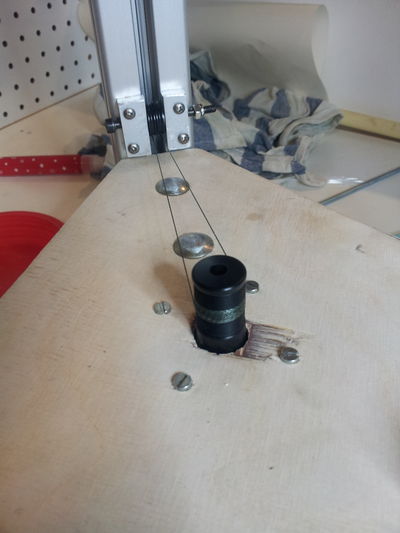
Stepper motor with 9 or 10 windings on axle (courtesy of Steve Graber of Grabercars)
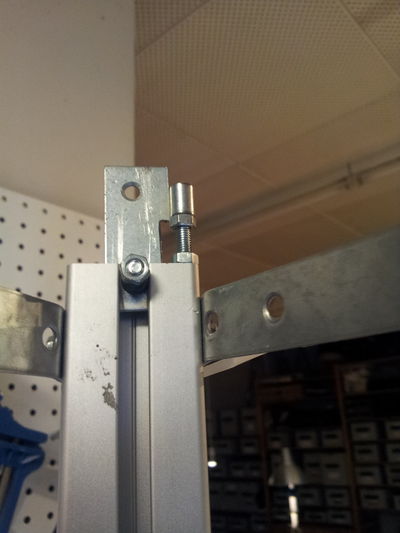
The tensioner with idler wheel inside extrusion
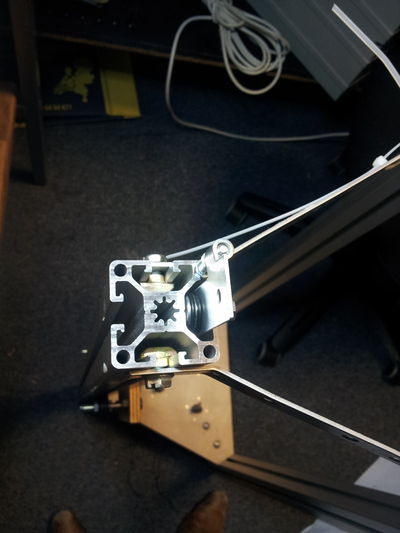
The tensioner with idler wheel inside extrusion, view from top
I asked BuZz of http://nurdspace.nl/Main_Page to print the three carriages and the platform in PLA. They came out excellent. They look a bit bashed now on the pictures but that is because of me filing them, not because they looked this way when delivered. Many thanks, BuZz ! Your printer creates amazing quality stuff!
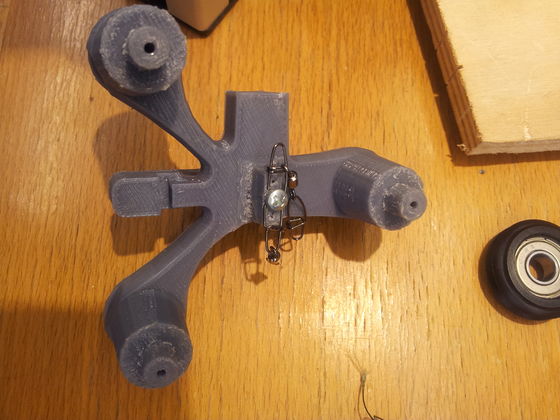
The printed carriages needed a fair bit of filing down due to differences in extrusion profile and the 105% scaling, but still trivial to do. I don't fear it will weaken the construction because the forces work in other directions than which would be risky.
Um, yeah. In case I hadn't mentioned: the original Cerberus parts were made for 1.5" extrusions. I deploy 40mm extrusions. 1.5 inch -> 40mm has a ratio of 1.0498687664 or 1.05x. Hence me printing them at 105% scale.
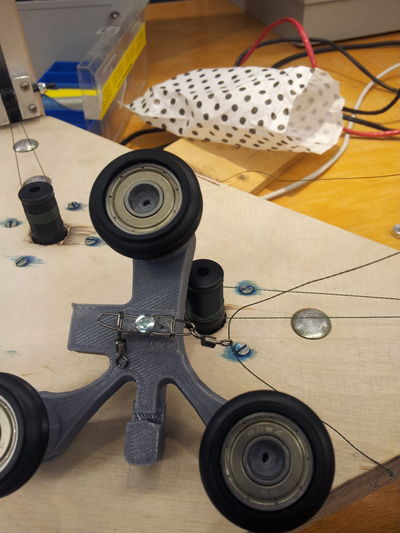
The 65lb fishing gear glands I first got were way too big to fit inside the extrusion cavity so I got smaller ones. I highly doubt the tension would ever really reach such immense levels under normal operating circumstances anyway. Oh and, making the knots is a major pain but with patience and perseverance... even my big clumsy male hands could eventually pull it off.
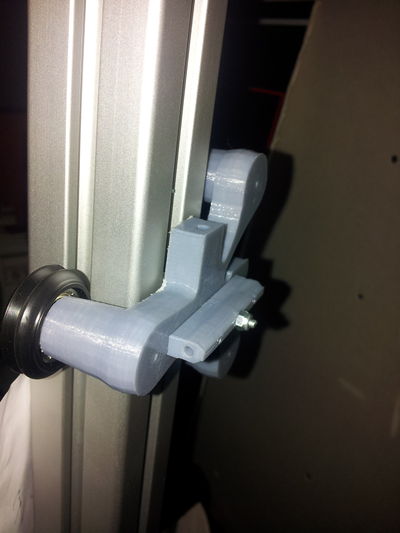
It seems to fit perfectly. A tad on the strained side but I see no ill effect from that. It very efficiently takes away all chances of play, so very very accurate
Milestone two
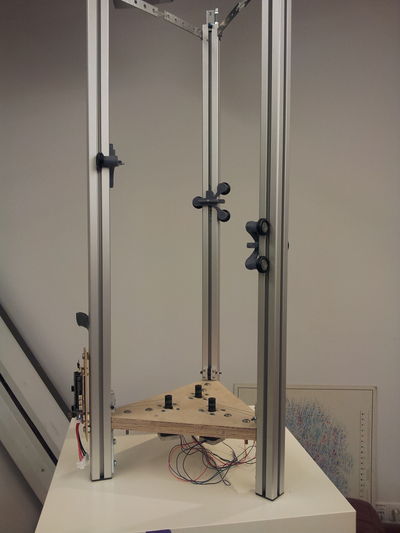
Milestone 2: All three carriages / axis mounted, threaded, moving smoothly, good to go!
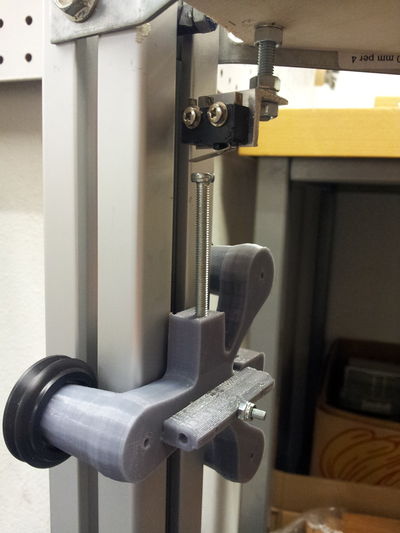
Just normal dependable mechanical endstops, none of this optical endstop blah blah. Mounted on a piece of thread to give the tensioner nut room to move all the way down. Later, I need to engineer it so that the latch of the microswitch doesn't get caught by the slotted screw head when the slot is exactly at a right angle to it. Or simply deploying other screws...
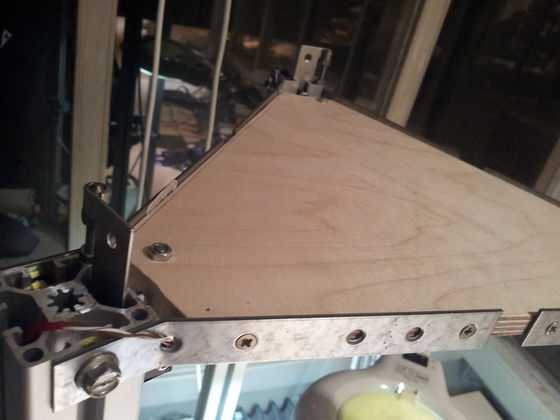
Top bracket also made out of wood. Much better looking than tiewraps!
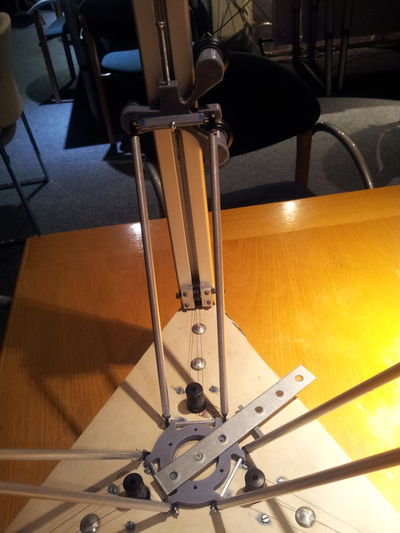
Four of the six arms done and glued. It is very hard to ascertain equal length, this is mainly because there isn't really any endstop anymore on the plastic joints; any that might have been there have been filed down while making it fit the ID of the aluminum tube. I'll do my best, and eventually redo ones that are bad. The two arms aren't exactly parallel, I am therefore thinking of redoing printhead platform joint connections with longer M2 threaded rod + 3mm aluminum tube... And I was about to find out just HOW MUCH those rods really needed to be exactly parallel too...!
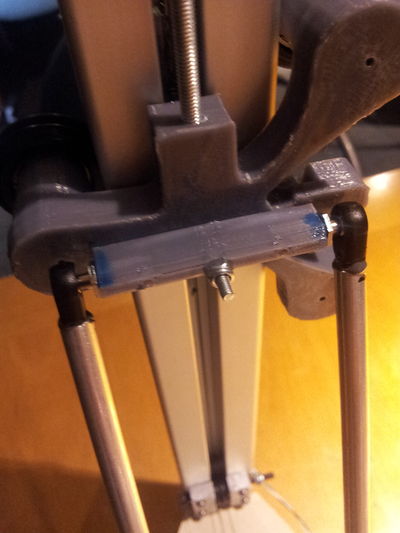
Closeup detail of top joints on carriage. The two-component adhesive I've used is interesting; it literally gives you maybe 120-150 seconds to deploy, after that it has become too hard already to use. Challenging stuff but quite neat and useful 'cause I really really hate to wait for glue to dry!
After all three axis were glued and I started moving the platform around I got quite a scare though. The platform didn't stay level! AT ALL!
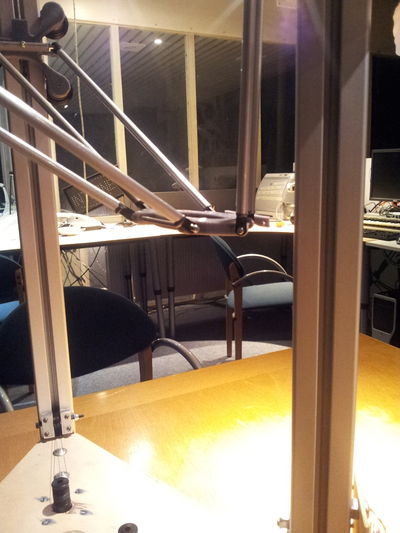
At first I thought that must have been because I reckoned the length of the rods was non-critical provided all six were identical. What stupidity of me ! Now I would have to do them all over :-(
Luckily, a forum pointed me to the real reason; it wasn't the length that was wrong, it was that I neglected to make sure the rods were perfectly parallel; At the top end their distance was wider by quite a margin than at the bottom end. And that -luckily- was far simpler to rectify.
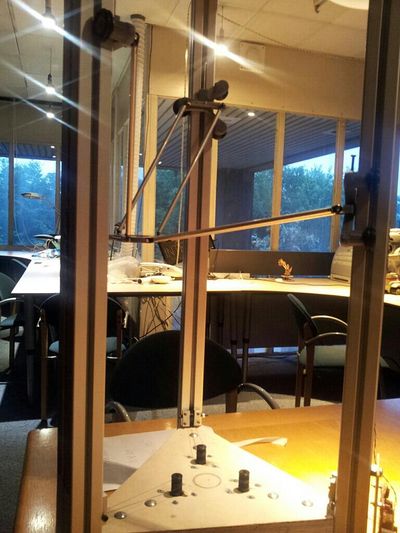
See here the result after rectifying that error. Now the rods are parallel, and the platform stays level throughout its field of movement now!
Filament, Hotend, etc
Today I did expect to receive my new minitronics controller board. But the PostNL mail delivery decided differently :-( Therefore, I spent today making other stuff, spending "too much" time making them too nice and neat, 'cause you need to make time pass... So I made a very nice filament spool holder with actual 608 bearings. And a mounting clamp for the J-head hotend.
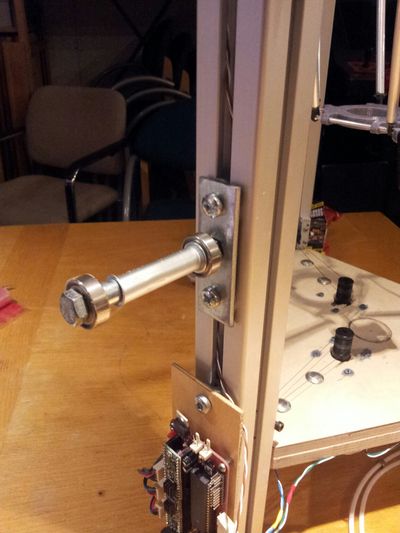
Made this with parts we had in stock. Well except 8mm rings, those I had to scavenge for everywhere: we need to stock up on those. I grinded one nut slightly askew, so the holder is a bit tilted so as to prevent the spool falling off. The extruder (Airtripper direct drive for bowden) will be placed just above this.
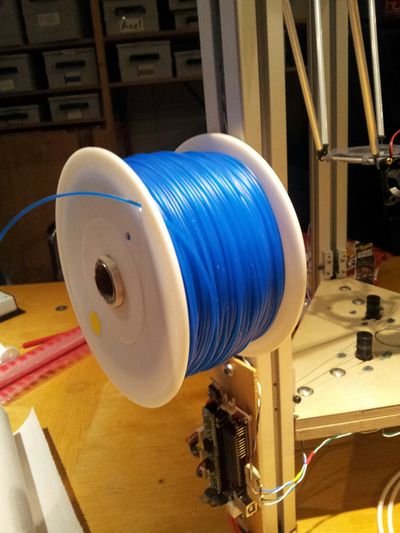
With 1 Kg reel of 1.75 mm filament. The plastic pipe it sits on I had to grind down a very small bit to make it fit into the spool. That was not nice: it is hard to turn down a pipe, even if only by 0.5 mm
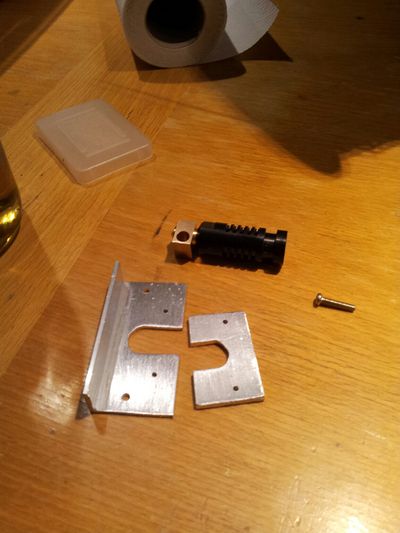
I found two pieces of aluminum that together were exactly the thickness of the slot in the PEEK hotend. Decided to make two U-forms that enclose it completely by placing one reversed. Did this extra-neat with lots of patience, pillar drill, drill fluid, very careful filing, sanding, caliper, etc. It fits like a latex glove around a hand. I use two M2 screws to hold the two halves together but they fit so tight, I'm confident the screws are unnecessary.
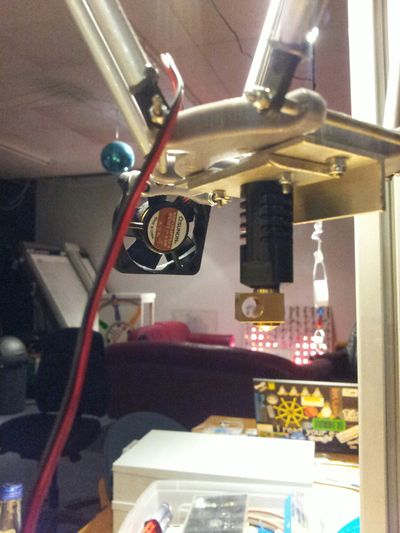
With mounted hotend bracket, J-head 0.5mm-for-1.75mm hotend, PLA cooling fan
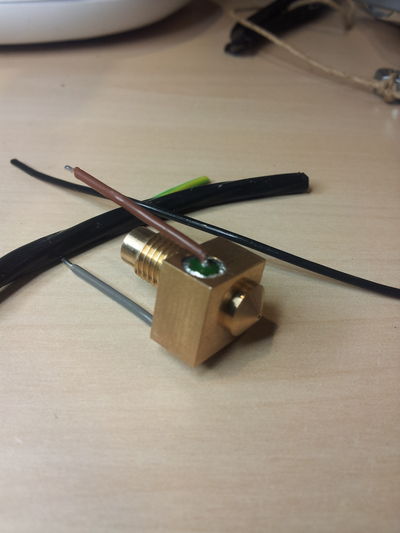
With painstaking precision I rolled I believe some 20-30 layers of aluminum foil around the heater resistor to make it fit very snugly in the channel. I like the result very much, but what a tedious and error-prone job that was...
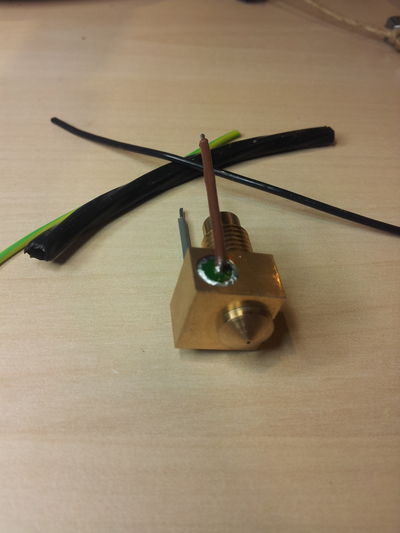
Before you laugh at me and tell me I'm stupid-- no, these aren't plastics around the wires, they're taken from a high temperature proof PTFE wire, you can still see the disassembled pieces of the wire in the immediate background. Will have to run endurance tests still, but first test was passed without a glitch: stuff doesn't start melting, even when heated with soldering iron for 20 seconds.
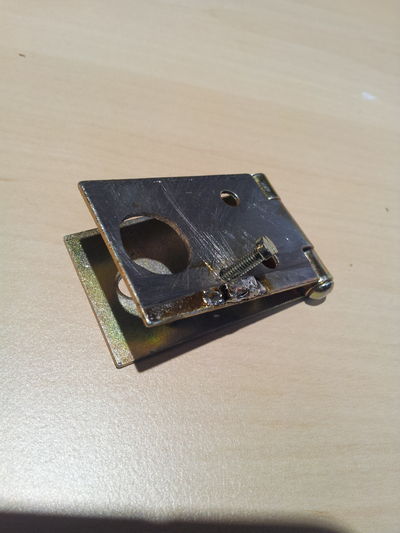
Okay so, some background info first. I use a bowden and a J-Head. Normally the J-Head comes with a hollow set screw to put enough pressure on the PTFE inside to prevent leaking, yet not prevent the PLA from moving by pinching too hard. But in my case, it is highly illogical to end the bowden just above the hotend, cross an air gap, and enter an identical piece of PTFE again inside the J-Head.
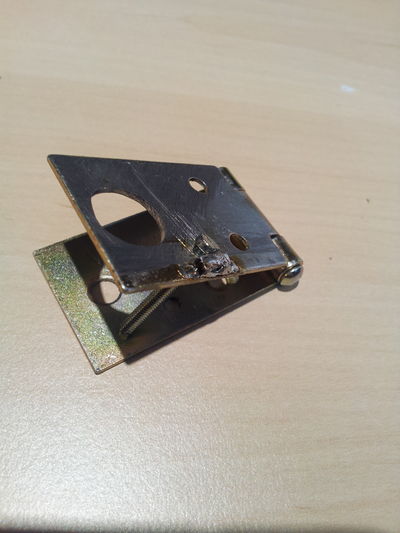
Therefore I had to improvise a bit. I need/want to deploy one continuous bowden PTFE from extruder motor, all the way inside to the hot nozzle. I needed something directly on top of the J-Head to be able to finely adjust the force by which the PTFE is pushed in. Enter a hinge and some drilling and soldering. The screw head is flattened on one side, together with the soldered-on ridge it prevents the screw from turning, yet still enables it to change orientation.
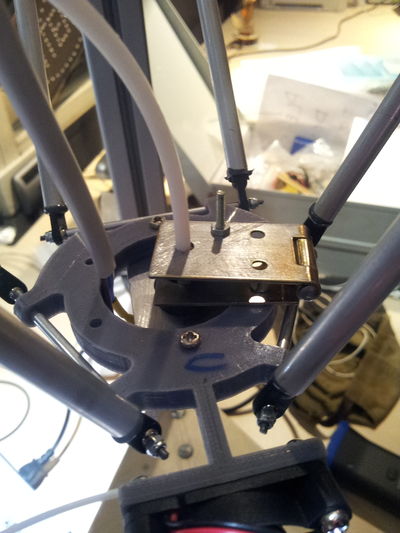
The assembly mounted on the platform. I used two tight-fitting nuts to try and grip the PTFE. We'll have to see how well that stands up to the pressure... Afterwards one needs to drill out the PTFE again with a 2.0 mm drill bit, because the nuts compress it to the point of not being able to pass the filament through the PTFE anymore.
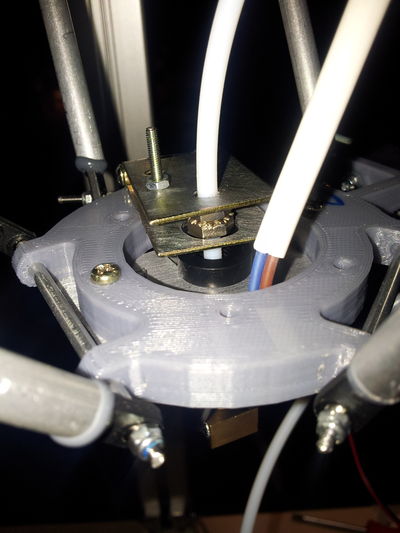
I plan to change the M2.5 nut you see (the adjuster for the pressure) to a wingnut if I'm able to source that. I also still need to devise some way preventing that nut from slowly loosening itself over time with the constant vibrations and movement.
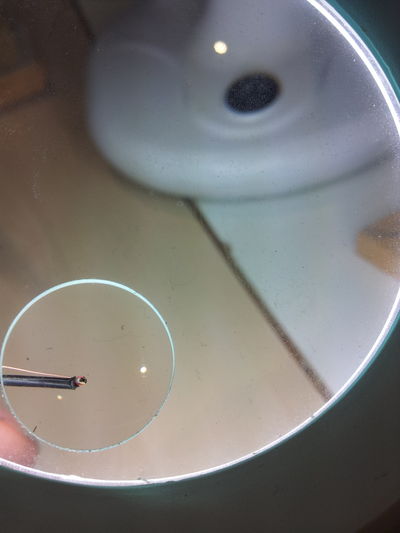
The mounting of the thermistor is, once you start thinking about it, a real challenge. The wires are not insulated, so they will gladly short against each other or against the metal hotend. I possess very thin lacquer-insulated wire but nothing tells me that would withstand 200 degrees Celcius. But it's worse still; one cannot expect a solder joint to hold when the temperature is steady around 200 degrees. And even if one could, the final stretch of wire will still be uninsulated, precisely at the critical spot: inside the tiny 2mm hole. So umm... Kapton tape? meh. Ugly, error prone, flaky. Then I thought of simply just insulating only one of its wires. The hotend isn't electrically connected to anything, so shorting the one wire to it has no effect. And insulating just one wire is very doable; I've used the same PTFE sheath from the dissected wire I used above, only now I made a tiny 1mm incision in the top, so the thermistor can be "half pulled in", making the insulation almost foolproof and greatly simplifying the insertion in its hotend spot too.
Calibration etc
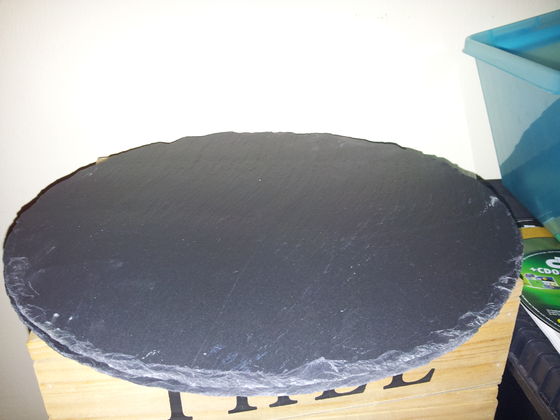
So in a bold and unprecedented move while looking to buy a round glass plate or mirror, I found this piece of slate in a shop. It looks fairly flat, was ridiculously cheap, and I suspect its heat conducting properties are much better than glass. I will try to use this as platform, either with or without a heat source underneath, and either with or without tape to help the PLA adhere. I stand to lose nothing; I can still purchase glass and throw this 3,50 euro investment in the trash if it is really unsuited.
Heh. Well, I used this to try and calibrate, which is a tough job; Sometimes the printer acts erratic, like not reacting to home (G28) commands or moving in random faulty directions, and the math doesn't add up if you recalibrate Z height, strangely enough (if you touch the platform with Z=58 and you decrease MANUAL_Z_HOME_POS with 58, Z=0 *does* *not* touch the platform... Go figure.
I did succeed in at least getting all the numbers nicely close to correct; it now hovers over the platform if I select Z=2, at equal distances in front of all three towers, and it also looks to have the same clearance in the middle. That is great progress compared to yesterday. But a lot of that is still visual, no measurements to back that up. And in hindsight that is a good thing, because the slate looks flat when you look at it with your eye, but when you hold a ruler over it you see very clearly it's not. It has at least 1mm-2mm difference in the middle. So it is a good thing I didn't spend hours precisely tweaking using that as my reference. So further work needs to be done, and a better work surface needs to be acquired.
You can see a short clip of it moving about over here: https://www.youtube.com/watch?v=B0ajfRH5b6k&feature=youtu.be
New Electronics!
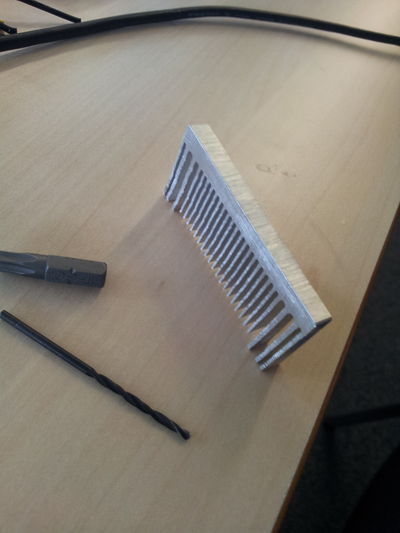
Received Minitronics board from reprapworld. As I believe in passive cooling I decided to put some sort of heatsink on the stepper drivers. I settled for making one strip that sits on top of all 4 chips, glued on with special heat-conductive glue. The glue took very long to cure, so that made things interesting. But anyway, this is the heatsink I created by carefully sawing off a slice of an old PC CPU cooler.
More about the software in a bit.
Heating up, extruding
After the calibration I couldn't stop myself from wanting to test the hotend+bowden+heater resistor I made. So I put in the thermistor with the use of some kapton, chose the right value in Configuration.h and very cautiously typed in "M104 S50" and lo and behold, it got warm! After some internal debate about not being able to pull the PLA out cleanly anymore I went and pushed it to 190 degrees and pushed in a length of filament through the bowden tube. And I pressed on. And yep, out it came, a nice thin blue strand of PLA. Whoa. Science, bitches! \o/
Now I really want my extruder...
Movement issues
Aside all this seemingly very good news, there is also bad news. In my enthusiasm I did press for some high speeds and the machine REALLY doesn't cope well with that. It resonates, it routinely shows very weird glitches as if the driving filament is rubber instead of spectra (jumping and hesitating and having severe hiccups and bumps, but still apparently not skipping because the attained end point is still where it is supposed to be (weird). I am unsure if my speed expectations are quite simply too high, or that I need to tweak speed settings so as to try and avoid resonance frequencies, or that the filament is too tight or too loose, the stepper current is too high or too low, some problems with bearings, whatever. Although we did experiment with the tension which didn't show improvement.
Maybe it is more of a software thing and acceleration settings must be tweaked and more intelligent movement commands instead of my crude GCode that tells it to very abruptly stop, change directions, etc. Who knows. But at the moment, it is no speed monster yet...
